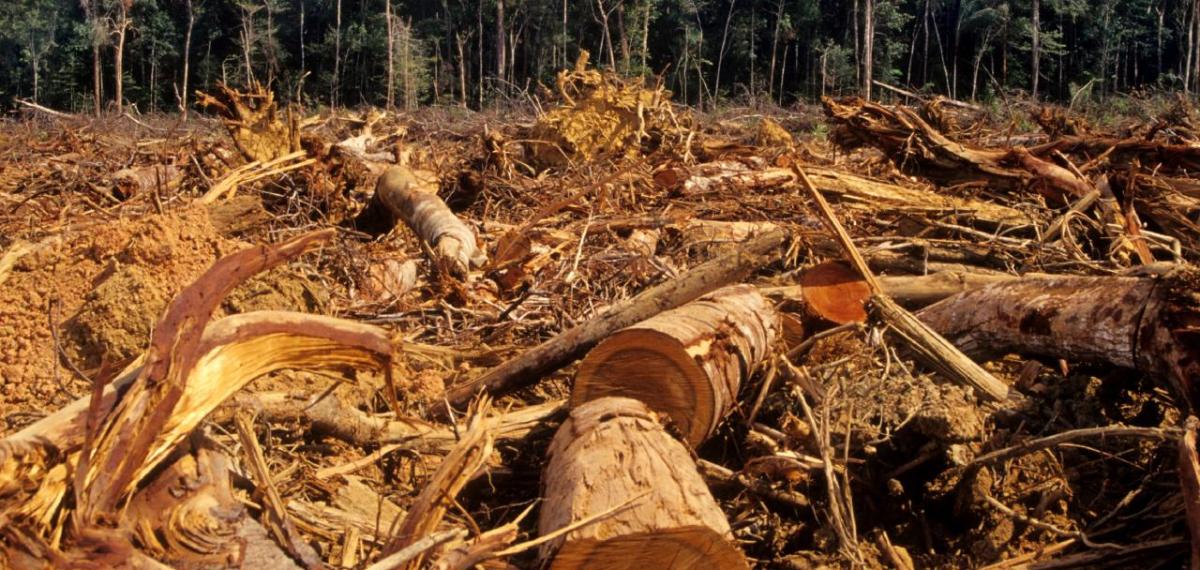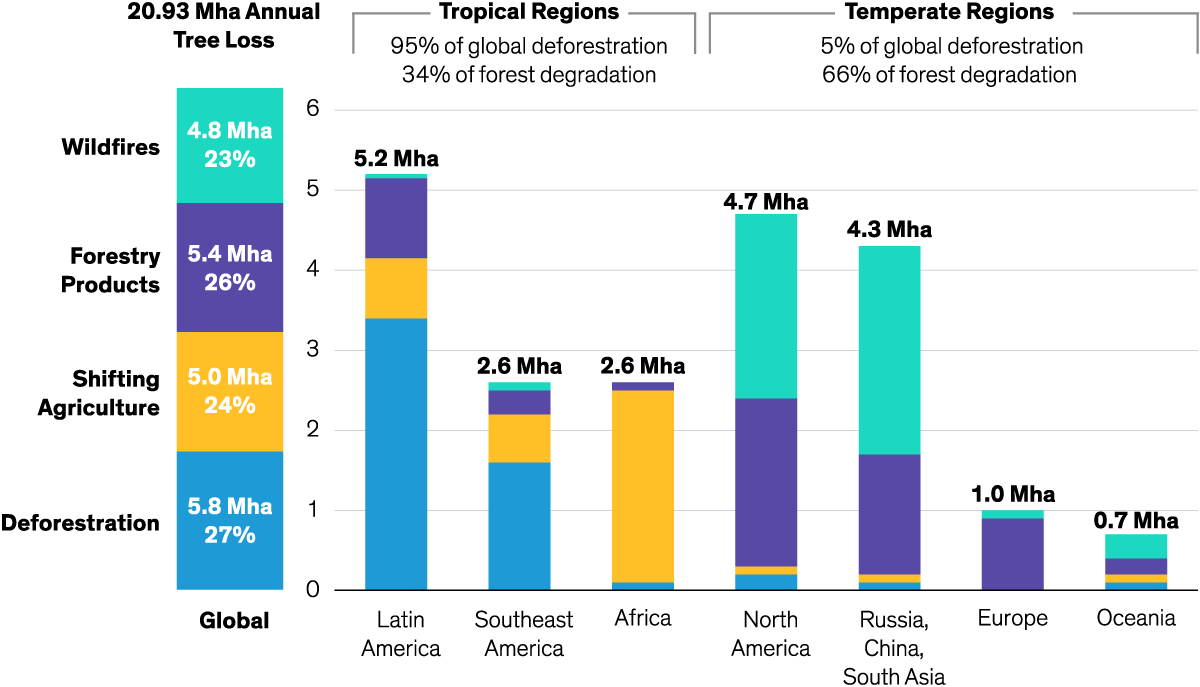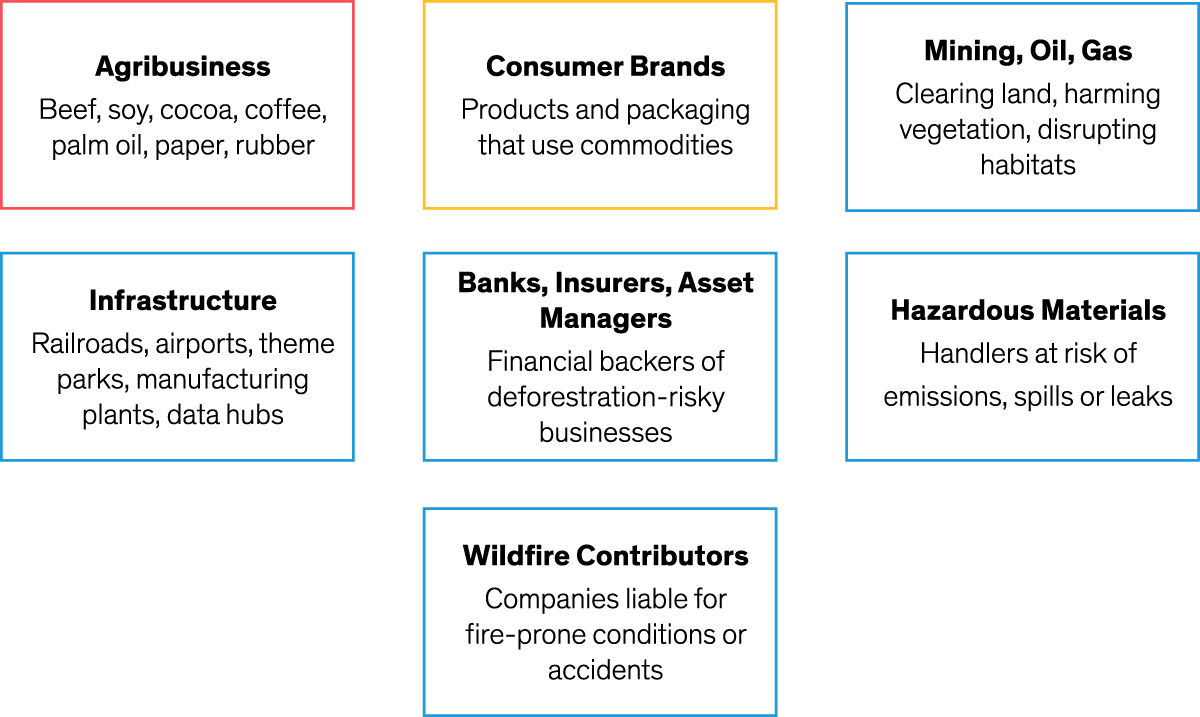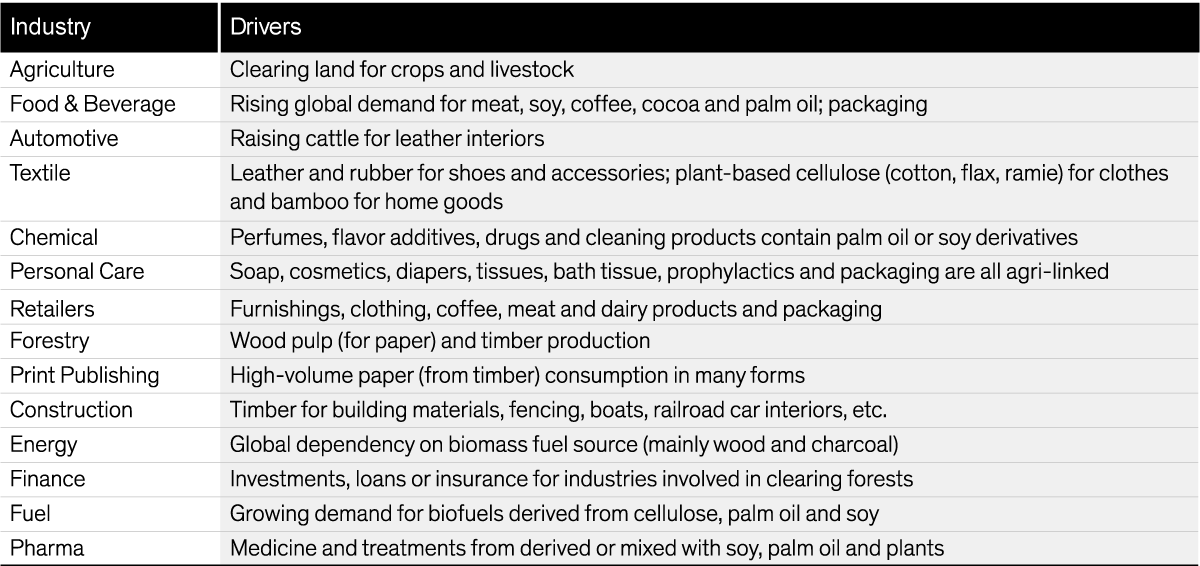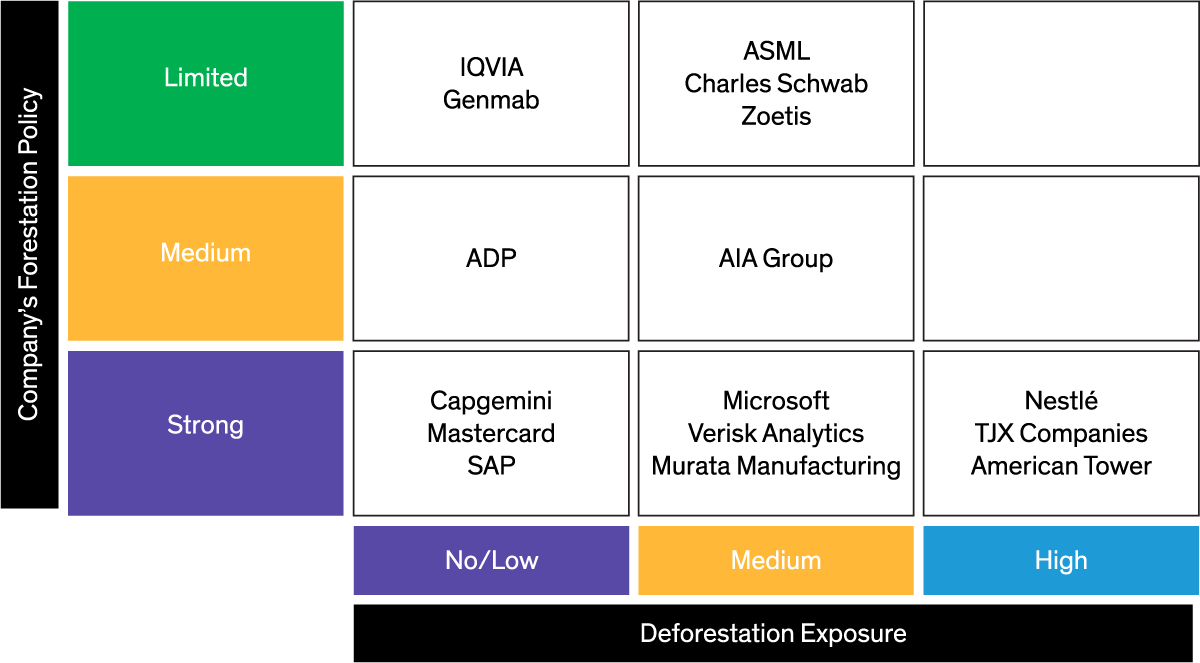AllianceBernstein: Tree Spotting - Detecting Deforestation Risks One Company at a Time
ESG in Action
Practically everyone has heard the phrase “save a tree.” Its call to action is more poignant and timelier than ever as whole forests are disappearing at alarming rates, often because of business activity. Equity investors must gain a greater understanding of how companies are impacted by and addressing deforestation—and how different approaches might affect long-term return potential.
The Issue
The world’s forests play a vital role in sustaining life, providing products and services and counterbalancing the effects of global warming. But they’re threatened, which also means companies and investors alike should understand deforestation’s impact and risks to the bottom line.
The Investment Case
Agriculture is deforestation’s chief driver, but practically every industry is either a contributor or exposed to it. The key is to know how and where a company is vulnerable and whether it has a policy to effectively respond.
Engagement Goals
Our research suggests that many companies don’t have adequate policies to address deforestation risk, so investors should engage with management to encourage awareness and improvement.
Authors
Dev Chakrabarti| Chief Investment Officer—Concentrated Global Growth
Sara Rosner| Director of Environmental Research and Engagement—Responsibility
From the dense Amazon jungle to wide stretches of Malaysian palm oil plantations, agricultural practices have been stripping the world of vital forests for decades. But now, as awareness grows, companies of all stripes—from e-commerce to sportswear—are being pressed to show how they’re addressing deforestation, which is as much a threat to businesses as it is to the planet.
Deforestation is the process of converting forests to non-forest uses, such as agriculture and roads. Some 31% of the world is covered by forests, about 10 billion acres in all. This is down from 11 billion 35 years ago, and the rate of disappearance is accelerating. In 2021 alone, the equivalent of 10 football pitches was lost every minute, according to the World Resource Institute.
Deforestation is a manmade problem, but problematic for all forms of life and livelihoods. About 25% of the world’s population relies directly on delicate forest ecosystems just to survive. Forests are home to 80% of the world’s biodiversity—all plants, animals and microorganisms in a given ecosystem. Therefore, they provide an essential balance of healthy soil, clean water, safe habitats, crop pollination and barriers to erosion and flooding.
Very few regions aren’t touched in some way. Declining forests threaten most corners of the globe, with temperate zones just as vulnerable as the tropics, albeit for different reasons (Display).
Aggressive natural resources mining, urban sprawl and shifting cultivation practices, for example, are driving permanent deforestation in tropical regions, especially Africa. But across North America, China and Europe, wildfires and logging farms are mostly behind forest degradation, when forest ecosystems can no longer provide goods and services to people and nature. Although it doesn’t necessarily lead to permanent tree loss, forest degradation is an even greater problem than deforestation and just as harmful to indigenous life.
Moreover, there’s a direct but tenuous link between forests and the air’s very breathability. Trees absorb about one-third of all emitted fossil-based CO2. But as greenhouse gas emissions (GHG) rise, a shrinking forest canopy will struggle to keep pace. Given this prognosis, the Intergovernmental Panel on Climate Change continually stresses that saving forests and planting new ones are key to hitting global targets aimed at limiting the annual temperature rise to 1.5° Celsius.
Meanwhile, deforestation will continue to have a direct impact on climate change and biodiversity loss. These two critical sustainability challenges are at the heart of environmental, social and governance (ESG) issues that we believe should be addressed by equity investors because of the risks and opportunities they pose to businesses across sectors.
Deforestation as an Investment Risk
Beyond its ties to climate and biodiversity, deforestation is tightly intertwined with global business. Whole industries and individual companies alike can be contributors to the problem and its solutions or can be among those affected by it (Display).
According to OurWorldinData.org, agribusiness—industries behind the world’s food supplies and other consumables—is deforestation’s greatest catalyst by far, especially in the tropics. Consumer brands are a close second. Both industries’ dominance mostly stems from the sourcing of just four “forest-risk” commodities: cattle, soy, palm oil and timber.
Deforestation’s nexus to agriculture and consumer products isn’t exclusive. From retailers to insurers, many business models can be linked to some degree. Even industries seemingly removed from deforestation could still be exposed, since supply chains often intersect with agricultural goods. Leather car seats, cotton jeans and palm oil–based topical ointments are just a few of the many subtle but significant cross-sector dependencies (Display).
Weighing Deforestation Risk in Stock Selection
The challenge for investors is to examine how well companies in different industries are managing potential deforestation risks and the opportunities it poses for their businesses.
For example, companies linked to deforestation can suffer reputational risk in the minds of consumers and advocacy groups, which can throttle customer loyalty and competitiveness. The ripple effect has stretched further and swifter in the social media age, as platforms tend to amplify ESG-related topics to highly engaged and vocal investors.
There are legal considerations for the bottom line, too, especially with the tighter regulatory scrutiny of climate-related financial disclosures now including deforestation impact, and the European Union’s deforestation regulation, expected in 2025. Some companies are out in front of this. Unilever and Nestlé, for instance, apply sophisticated technology to trace and report their deforestation risk exposure from source to shopping cart. Some 90% of Nestlé’s forest-risk commodities are assessed through satellite monitoring as deforestation-free as of 2020.
Not all companies are as self-aware. In fact, many business models that seem arm’s length from deforestation can be unwitting parties to it and equally susceptible. Banks that lend to the logging industry are indirectly supporting widespread tree removal, for example, and providers of digital-based work-efficiency solutions are steady superusers of bulk printer paper.
Identifying deforestation risk is only a start, though, and investors also need to know what a company plans to do about it. That is, does the business have a forestation policy to help mitigate its exposure and can its results be quantified?
Putting Companies to the Deforestation Test
AllianceBernstein’s (AB) Concentrated Global Growth team conducted a comprehensive deforestation analysis of more than 100 companies within the investable universe for the equity portfolio. Guided by a list of strategic questions (Display), we aimed to identify risks, and survey and analyze the extent of each company’s forestation policies, if any.
Our sample universe comprised a wide range of companies, with 46 based in the US, 32 in Europe and 49 from Asia. Market-capitalization size varied too, as did their value and growth tilt, industries and sectors, including technology, energy, manufacturing, retail and media.
We began by reviewing sustainable investment reports, whether specific to ESG or part of broader annual statements. Relevant words and phrasing such as “tree,” “forests,” and “cardboard” were flagged. Sections in which they were found were closely examined for context and materiality.
To help quantify deforestation exposure and risk levels, we sought to measure the percentage of an organization’s revenue that was dependent on key forest-risk commodities, as reported the prior year. Among companies with active forestation policies, we looked further into commodity sourcing and traceability, which we think speaks to a firm’s commitment and progress. That is, can the company trace commodities to their product origins, or at least to the point at which it can assure their compliance with its policies? Likewise, we asked to what extent suppliers were onboard with their policy.
The Takeaway: Deforestation’s Impact Still Underappreciated
Our analysis revealed a wide span of awareness and action plans surrounding deforestation risks, which seemed to turn up in practically every industry or sector represented.
For instance, deforestation risk levels among food producers, whose lifeblood is farmed ingredients, naturally scored high. But while an online retailer might seem to be less exposed, the picture changes when we see the vast acreage of canopy cleared to make raw materials for its products and packaging.
Interestingly, financial companies aren’t as removed from deforestation risk as they would seem. Our analysis showed that eight financial firms were exposed by association, though three—all US based—have limited policies in place, among them Charles Schwab.
Across the companies we surveyed, only about half had a forestation policy, which can cover a spectrum of initiatives to help undo the damage. For instance, reforestation entails planting trees or allowing them to regrow where forests stood until very recently; afforestation involves planting trees on stretches long devoid of forests; and forest restoration helps degraded forests recover their structure, ecological processes and biodiversity.
The universe included no companies directly tied to agribusiness, but 34% were tangentially connected. Despite their exposure, about 22% were short on any forestation focus. Among these were Genmab, the Denmark-based biotechnology firm, and Tencent, the Chinese multinational technology company. Tencent is, however, committed to eco-friendly operations, leveraging technology to promote sustainable use and protection of natural resources. For example, the company applies artificial intelligence and cloud-computing technologies to nature-based solutions to tackle digitalization and efficiency issues arising in the process of ecological conservation. And Genmab receives an A rating from Ethos ESG in the categories of access to affordable healthcare and child and material health.
Meanwhile, American Tower, a US real estate investment trust, and TJX Companies, a US retail group, both ranked high in deforestation risks but have strong programs to counter them. American Tower, which clears land to build and lease wireless communication infrastructure, has committed to replace each tree it removes with 50 throughout the US high plains and California. Through our research, we developed a framework that provides a good starting point for investors to assess a company’s exposure to deforestation risk and forestation policies (Display), which can help guide engagement efforts.
Technology can be vulnerable to deforestation risk, too, although we discovered that most tech-related companies have ambitious policies to go with them. US-based Verisk Analytics, for instance, funds major reforestation efforts in Brazil, while France’s Capgemini joined the Lowering Emissions by Accelerating Forestation (LEAF) Coalition, whose goal is to halt deforestation by financing large‑scale tropical forest protection. Meanwhile, Japan-based Murata Manufacturing employs a fully staffed and audited forest program to protect woodlands in developed areas throughout the country, especially near its plants.
A small number of companies, such as Mastercard and SAP, are being preemptive by employing forestation efforts even though they’ve little deforestation exposure. Mastercard’s Priceless Planet Coalition, for example, spans 15 forest restoration projects across six continents; SAP, the German software company, has pledged to plant five million trees by 2025
Our findings suggest that companies are only beginning to wake up to the global problem of deforestation. So we think it’s important to include the issue as part of overall ESG research and engagement processes. As more companies discover that deforestation matters to their business activities, investors and other stakeholders, we believe they will increasingly quantify their exposure and demonstrate the success of their policies.
Deforestation in the Broader ESG Picture
From the American Southwest to the North Sea, the global warming alarm has been especially shrill in 2023. Record flooding, windswept fires and back-to-back heat waves remind us that climate change is real and intensifying, along with the physical and transition risks and opportunities to industries and companies. It’s even more reason for diligent equity investors to integrate these material issues into their fundamental research and stock selection processes, since fundamental analysis is invaluable to discovering how the potential impact of deforestation can affect a firm’s long-term earnings outlook.
ESG analysis is rapidly evolving. New methods to assess ubiquitous climate change risks and opportunities continue to emerge and find relevance. Deforestation is one more important input alongside other key gauges like carbon footprint, carbon handprint and climate scenario analysis.
Based on our research, the dire threat of deforestation and its priority level among companies are way off balance. But we believe that will improve as more companies adopt more rigorous forestation policies, and measure and manage their risks and opportunities stemming from this issue. Engaged investors have an important role to play in raising awareness among management teams that taking a strategic approach to deforestation is good for the planet, profits and long-term investment returns.
The views expressed herein do not constitute research, investment advice or trade recommendations and do not necessarily represent the views of all AB portfolio-management teams. Views are subject to revision over time.
References to specific securities discussed are not to be considered recommendations by AllianceBernstein L.P.
Learn more about AB’s approach to responsibility here.

